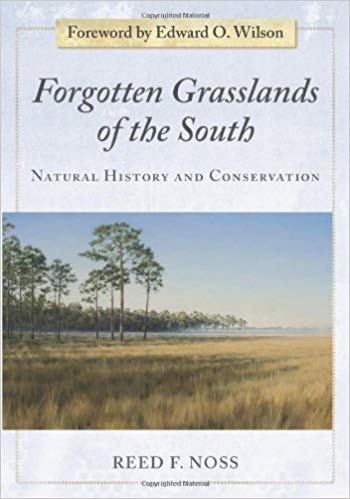By Reed Noss
Reviewed by Jonathan O.C. Kubesch, University of Tennessee

I work in the space between traditional agronomy and ecology with my career in grasslands. While I refer to journal articles for the bulk of my work, a reference book holds an important place for my field. Generally, I go to the library or through hearsay to come across some obscure text with a great description of this species or that agricultural practice. Ah, the life of a graduate student! However, in the case of Reed Noss’ Forgotten Grasslands of the South: Natural History and Conservation, I could not have found a better time to dive into a well-assembled dissection of these oft-overlooked ecosystems. My copy comes courtesy of Dwayne Estes (Southeastern Grasslands Initiative), and came it to me while in the field looking for running buffalo clover (Trifolium stoloniferum) in Davidson County, Tennessee. After an unsuccessful hunt, I poured over the book in concert with my own travels around the Southeast.
Noss thoroughly expands the conceptual grassland well beyond the tallgrass and mixed-grass prairies of my background to include the glades, buffalo traces, and barrens. Following the author’s same journey as an Ohio buckeye gone south, I happened to visit Myakka State Park in Florida as part of my best friend’s wedding and got a similar feel for Southern grasslands that Forgotten Grasslands highlights in an interweaving description of basic ecology and applied conservation. While broad in geographic range, the book gives a great description of the Bluegrass Region and some of the floral diversity present within the relatively developed region. Having just sampled the native clover in the region, I then read into the magic of my travels within the wider context.
The grassland ecological model put forward is a strong one for natural systems and is explored in the context of systems dominated by fire, soil, water, and herbivory. Kentucky’s ecological diversity offers examples of all these natural processes. KNPS members might think of river scours in comparison to calcareous glades. Colorful plates showcase the diversity of ecosystems and the species richness within these systems. Land Between the Lakes and the inner Bluegrass are featured alongside Blue Licks Battlefield State Park.
Conservation is a key concern in Kentucky’s native plant sphere. In addition to the floral diversity of the Southeast, the economic opportunity, favorable climate, and social hospitality have led many to move here. Rather than running out these recent arrivals, highlighting this biodiversity and the backyard endemism is seen as a promising strategy to improve the future of these plant species. While not everyone will push through a Solidago key, we can all appreciate the various forms that grace the state. Even outside of the strict grassland context, Daniel Boone National Forest and Big South Fork offer well-marked sandworts for beginners and a diversity of pignuts (Carya spp.) for the initiated.
Forgotten Grasslands of the South appeals to the reader as a primer on these often overlooked ecosystems. Most of us have a collection of carefully-chosen botanical curations and do not generally gather the wider system. However, Reed Noss has succeeded in seeing the grassland through the trees.
Acknowledgements
Special thanks to John A. Lodi of Ann Arbor, Michigan for inspiration and suggestions on this review. Thanks to the Chance and Lodi family for giving me a relaxing time to read and discuss this book with a wider popular audience.
Jonathan Omar Cole Kubesch is a graduate student pursuing a master’s degree in crop science at the University of Tennessee. He studied evolution and ecology—as well as agronomy—at the Ohio State University. He works on forages, grasslands, and prairies with a particular passion for native clovers.
